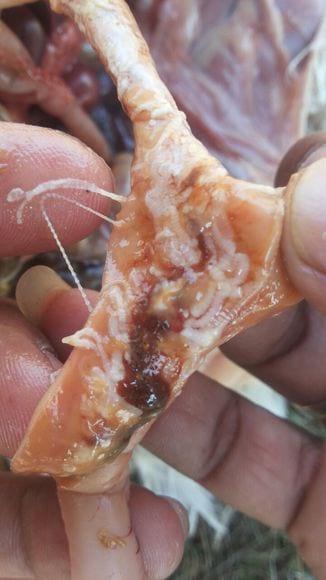Tapeworm Infestation in Commercial Broiler - Age 34 Days (Field Case)
We can see tapeworm infestation in backyard poultry, layer chicken as well as in breeder chickens too but due to short life cycle of culling in commercial broilers i.e. around 40 days, it’s difficult to found tapeworms in broiler birds.
Apart from that, in rainy season due to poor litter management & favorable conditions for growing of intermediate hosts like ant, beetles, snails & slugs etc, many broiler integrator losing their productivity in the months of Aug/September & October every year.
Control of Intermediate host is the “KEY of SUCCESS”
Figure 1-Age 32 Days - Sept.2014
Figure 2- Age 36 days - Oct.2014
Figure 3-Age 34 Days - Nov.2014
Figure 4-Age 34 Days - Nov.2014
Flatworms that infect poultry include TAPEWORMS (cestodes) and flukes (trematodes).
Tapeworms are white or yellowish ribbon-like segmented flatworms. Tapeworms grow by forming new segments (called proglottids) just behind their head (scolex). Each segment contains both male and female sexual organs. The tapeworm attaches itself to the wall of the intestine with the scolex. As it grows, segments on the tail end mature and break off, passing out of the intestine with the droppings. The excreted segments are filled with “eggs”, which are actually first stage larvae. Tapeworms have an indirect lifecycle. Insects and other arthropods eat the excreted segments and become intermediate hosts for the parasite. Many tapeworms require a specific intermediate host. Poultry become infected by eating infected intermediate hosts.
Flukes are flattened, unsegmented, leaf-like parasites. Flukes are hermaphroditic (each individual has both male and female sex organs) and all trematodes that infect poultry have an indirect lifecycle. Their lifecycles vary in complexity and can involve up to four hosts. More than 500 species have been found in birds but only a few are known to cause disease.
Cestodes (tapeworms) also vary in size. Raillietina spp may be >12 in. (30 cm), whereas Davainea proglottina often is <0.16 in. (4 mm). The proglottids of individual tapeworms are hermaphroditic. Tapeworms have been recovered in the thousands from individual chickens and turkeys.
Common Cestodes of Poultry
Parasite Host Intermediate Host or Life Cycle Organ Infected Pathogenicity
Cestodes
Choanotaenia infundibulum Chicken House flies Upper intestine Moderate
Davainea proglottina Chicken Slugs, snails Duodenum Severe
Metroliasthes lucida Turkey Grasshoppers Intestine Unknown
Raillietina cesticillus Chicken Beetles Duodenum, jejunum Mild
Raillietina echinobothrida Chicken Ants Lower intestine Severe, nodules
Raillietina tetragona Chicken Ants Lower intestine Severe
Transmission
Modern confinement rearing of poultry has significantly reduced the frequency and variety of endoparasite infections, which are common in ranged birds and in backyard flocks. However, severe parasitism still may be seen in floor-reared layers, breeders, turkeys, or pen-reared game birds where management problems may exist. Contributing factors include the use of poorly managed built-up litter (which fosters the propagation of intermediate hosts and the accumulation of infective eggs) and resistance of the parasites to therapeutic drugs. Range infections of nematodes such as Heterakis gallinarum and Syngamus trachea may increase because of seasonal or climatic abundance of specific invertebrate intermediate hosts, eg, large numbers of earthworms brought to the surface by spring rains. Some species have been associated with large numbers of darkling beetles, which may act as mechanical vectors of infective eggs.
Nematodes have either a species-specific, direct life cycle with bird-to-bird transmission by ingestion of infective eggs or larvae, or an indirect cycle that requires an intermediate host (eg, insects, snails, or slugs). Eggs of many nematode species are resistant to low temperatures and disinfectants but may be more susceptible to heat and desiccation.
Cestodes require an intermediate host (eg, insects, crustaceans, earthworms, or snails). Floor layers, breeders, and broilers are infected with Raillietina cesticillus by ingestion of the intermediate host, small beetles that breed in contaminated litter. Cage layers in unscreened houses may become infected withChoanotaenia infundibulum by eating its intermediate host, the house fly. Litter beetles in proximity may also serve as intermediate hosts.
Microscopic image of a cysticercoid
(The larval stage of tapeworms).
The tapeworm's scolex (head).
This attaches to the intestine of the definitive host.
Numerous tapeworms attached to
the intestinal tract of an infected bird.
More than 3,000 of the microscopic tapeworm Davainea proglottina have been recovered from a single bird. Several species of slugs and snails serve as intermediate hosts, and >1,500 infective parasites have been recovered from a single slug.
Pathogenesis and Clinical Findings
Most pathogenic tapeworms are found in the small intestine; the scolex, usually buried in the mucosa, generally causes mild lesions. Davainea proglottina may cause weight loss. Raillietina tetragona causes weight loss and decreased egg production; R echinobothrida produces granulomas at its attachment sites (“nodular disease”).
Diagnosis
A reliable diagnosis can be made only by accurate identification of the individually recovered parasites; careful and complete necropsy techniques are essential. Only by specific recognition of the parasite can meaningful recommendations for flock therapy and management be made.
Treatment and Control
Improvement of management and sanitation in confined operations will generally lower the parasite levels in the birds. In range birds, the only option is to move to new pastures, although the benefit that may result will be of short duration. Application of approved insecticides to soil and litter when premises are unoccupied may interrupt the life cycle of the parasite by destroying its intermediate host. When the premises are restocked, groups of birds of different species or ages should be widely separated to avoid spread of parasites. Migration of litter beetles or other insects may infect new or widely separated housing.
Approved compounds are very limited in the USA. Because of frequently changing regulations, the status of any medication should be checked before its administration. Only approved drugs may be used in birds producing eggs or meat for the commercial market. Label directions and recommended doses should be followed precisely, with scrupulous adherence to withdrawal times.
THE LIFE CYCLE OF THE TAPEWORM (also called "cestode")
Poultry tapeworm larvae live in creatures like slugs, snails, ants, beetles and flies - these are known as the Intermediate host. When a chicken ingests one of these, the larva hatches and attaches itself to the intestinal wall. The chicken is the Final host.
Within two to three weeks it becomes a fully grown tapeworm.
Then at least once a day the tapeworm releases it's "tail" segment, called a cyst. The cyst is passed out with the faeces and wriggles (yes wriggles) out of the chicken's poo and onto the nearest vegetation.
When the cyst dries out it releases its eggs, which in turn are eaten by the host creature, and so the cycle begins again.
SO HOW DO I KNOW IF ANY OF MY CHICKENS HAVE TAPEWORM?
You need to inspect as many fresh poos as you can for the cysts. I would suggest you place a fresh poo on a piece of paper towel, leave it for a couple of minutes, then have a good look with a magnifying glass.
An infected chicken will not pass cysts all the time, just in a few poos per day (mine were mainly in the evenings).
If you put the chicken poo onto a paper towel, it may leave a bloody tinge around it. Cecal poos may be very frothy and yellowy.
A worm egg count by a vet will not necessarily pick up on tapeworms because there will not always be cysts in the poo.
SO IF I WORM MY CHICKENS REGULARLY THEY WON'T GET TAPEWORM THEN?
The usual wormers licensed for poultry WILL NOT kill these critters!
FLUBENVET - NO
IVERMECTIN - NO
SOLUBENOL - NO
PANACUR - NO (although some vets may want you to try this option first)
SO WHAT DOES KILL THEM?
Actually - tapeworms are very hard to kill. The treatment will only paralyse the worm, making it release it's grip on your birds' intestines.
The treatment is usually used for horses, and is the active ingredient in dog and cat wormers.
It is important to remember that the treatment is NOT licensed for poultry, and so you must be aware that there may be risks involved. However, I used it on several exbats of various ages, and also on pure breed hens with no obvious ill effects.
The treatment is Praziquantrel. This is usually available as a tube of paste (like toothpaste), which would be sufficient for a heavy horse. A chicken only needs a tiny amount, the size of a small pea.
Alternatively, you could use a cat worming tablet, such as 'Drontal', which also contains praziquantrel. This is handy if you only have one hen with tapeworms.
COMMON QUESTIONS
Q. What if I leave tapeworm untreated?
A. Tapeworms are not as deadly as roundworms (which will block the intestines if untreated), but they are feeding off your bird's body, and can be around a foot long, so would you fancy them? Q. What if other chickens eat the cysts from an affected bird? A. They will not get tapeworm, as the cysts need to "hatch" and be eaten by a 'host' critter first.
Q. Can my chickens get tapeworms from my dog or cat?
A. No - tapeworms are host specific, and in any case the above answer would still apply. Q. Can I get tapeworms from my chickens?
A. No - again, host specific. (The main source of tapeworms in humans is uncooked pork). Q. Can I eat eggs after using praziquantrel?
A. Not advised for at least 7 days.
Q. What if I still see cysts after treatment?
A. Wait at least a week before considering re-treatment.
Q. If one of my hens has tapeworm, won't they all?
A. Not necessarily. Because chickens are intermediate hosts, it is possible that the others will be clear. It appears to be most common in the 'fly catchers' in your flock!
Q. Should I routinely treat my flock for tapeworm as a precautionary measure?
A. NO. The treatment will not prevent tapeworm, it will only act upon any existing ones.
Q. Are tapeworms more likely to affect free-range flocks?
A. Definitely NOT! Most cases I have come across involved exbats and hens kept in runs. After all - even battery hens are able to catch flies aren't they? Chickens in runs will still be able to catch flies, ants etc too.
Beetle Top left to bottom right: female golden stag beetle (Lamprima aurata), rhinoceros beetle (Megasoma sp.), a species of Amblytelus, cowboy beetle (Chondropyga dorsalis), and a long nose weevil (Rhinotia hemistictus).
Scientific classification
Kingdom: Animalia
Phylum: Arthropoda
Class: Insecta
Subclass: Pterygota
Infraclass: Neoptera
Superorder: Endopterygota
Order: Coleoptera
Linnaeus, 1758
With Warm regards, Dr. Jaydip


















